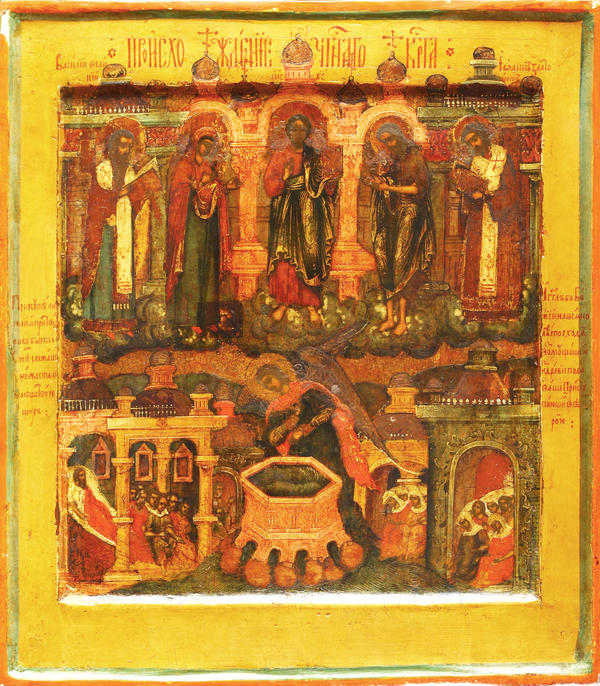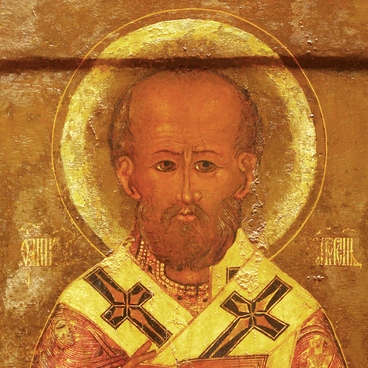The icon came into the I.D. Voronin United Museum of Local History of the Republic of Mordovia (I.D. Voronin NMLHRM) collection in 1982. The feast the Venerable Wood of the Life-Creating Cross of the Lord has been celebrated by Orthodox Christians annually on August 1 (August 14, new style) since the IX century. On this day, a piece of the cross from Calvary, which was stored in the Palace Church of Constantinople, was transferred to the St Sophia Cathedral, where the water blessing was held. After that, the priests walked with the Shrine through the streets for two weeks and performed divine services to get rid of all ailments. The word ‘origin’ in the name of the Church festival appeared due to an inaccurate translation from the Greek word meaning ‘solemn ceremony’ or ‘procession’.
In Russia, this holiday was widely celebrated at the end of the 14th century, when the Jerusalem Statute was introduced-a book that determined the order of Church services and regulated the use of the main liturgical writings in the Byzantine Christian tradition.
According to the researcher E. P. Salikova, the Gospel readings during the blessing of water, as well as illustration of hymns the glory of the Holy Mother are the main foundation for this icon. One of the earliest surviving icons is in the Suzdal Pokrovsky monastery. It dates from 1515.
According to the state of this icon, the restorers determined that it was repeatedly updated. During the restoration of 1985-1987, many traces of nails were removed from the icon, which remained from the lost icon-settings and crowns. According to some restorers, the fields of the icon do not correspond to the mullion-the central part of the icon board, and were rewritten about a hundred years ago.
Unfortunately, all the upper layers of the faces of the saints (except for the face of Basil the Great) were washed away, so it is not possible to determine the affiliation of this icon to any school. However, according to the ways of depicting the folds of clothing and the features of the ark of the icon, it can be assumed that it was created in one of the professional workshops of the Volga region.
On the icon the following inscriptions are preserved:
- above: ‘The origin of the life-creating cross’
- above the Lord: ‘iис хс’;
- over the head of Basil the Great: ‘Василiй великiй’;
- over John Chrysostom: ‘Iо (омега)аннъ златоустъ’;
- on the left: ‘При купели// жепят притво// ровъ бысть// в тех слежаш// [м]ножество// немощствую// щихъ’;
- on the right: ‘Агглъ Бо// жiй на всяко// лето сходя// возмущаше ю// и здравiе пода// ваше присту// пающим ве// рою’.
In Russia, this holiday was widely celebrated at the end of the 14th century, when the Jerusalem Statute was introduced-a book that determined the order of Church services and regulated the use of the main liturgical writings in the Byzantine Christian tradition.
According to the researcher E. P. Salikova, the Gospel readings during the blessing of water, as well as illustration of hymns the glory of the Holy Mother are the main foundation for this icon. One of the earliest surviving icons is in the Suzdal Pokrovsky monastery. It dates from 1515.
According to the state of this icon, the restorers determined that it was repeatedly updated. During the restoration of 1985-1987, many traces of nails were removed from the icon, which remained from the lost icon-settings and crowns. According to some restorers, the fields of the icon do not correspond to the mullion-the central part of the icon board, and were rewritten about a hundred years ago.
Unfortunately, all the upper layers of the faces of the saints (except for the face of Basil the Great) were washed away, so it is not possible to determine the affiliation of this icon to any school. However, according to the ways of depicting the folds of clothing and the features of the ark of the icon, it can be assumed that it was created in one of the professional workshops of the Volga region.
On the icon the following inscriptions are preserved:
- above: ‘The origin of the life-creating cross’
- above the Lord: ‘iис хс’;
- over the head of Basil the Great: ‘Василiй великiй’;
- over John Chrysostom: ‘Iо (омега)аннъ златоустъ’;
- on the left: ‘При купели// жепят притво// ровъ бысть// в тех слежаш// [м]ножество// немощствую// щихъ’;
- on the right: ‘Агглъ Бо// жiй на всяко// лето сходя// возмущаше ю// и здравiе пода// ваше присту// пающим ве// рою’.



